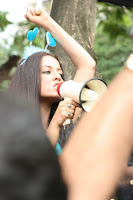 Elections '09 seems to have opened the flood gates of Independent candidates, especially in Mumbai. Independents have been a regular feature come election time - rebels who stand as independents when their political party denies them a ticket and if elected drive a hard bargain to prop up a coalition government. This time a new breed of candidates, untarred by the political brush, have decided to throw their hat in the ring in urban centres, and are receiving adulation and press coverage.
Elections '09 seems to have opened the flood gates of Independent candidates, especially in Mumbai. Independents have been a regular feature come election time - rebels who stand as independents when their political party denies them a ticket and if elected drive a hard bargain to prop up a coalition government. This time a new breed of candidates, untarred by the political brush, have decided to throw their hat in the ring in urban centres, and are receiving adulation and press coverage. There is a banker from Mumbai-Meera Sanyal, dancer Mallika Sarabai from Ahmedabad, low cost airline pioneer Captain Gopinath from Bangalore, among others. They are educated, have successful careers, but their biggest asset if blog land is to be believed is that they are not politicians.
Would I vote for them? Hmmmm.... My uneasiness with the candidates comes from the fact that what do I know of them besides the fact that they are people like you and me. With a politician, a voter knows where he stands. A politician makes a career of soliciting my vote with promises of development and a better future. Even if he doesn't fulfill any of those promises, I know that the politician will still come back to me after five years.
I cannot say that for sure with some one who Shobhaa De calls the ``prim and propah Malabar Hill memsaab''. A career politician can be held accountable at least once in five years - or five years after that. But, not so some one who has decided to ''do something for the country'' just before the elections.
This is not to say only politicians deserve to be voted to power. Gimme an independent candidate with some record of public work or civic activism, who knows his career depends on the the common wo/man. Gimme some one like Adolf D'souza, who was elected a corporator from Juhu - he was a person like you and me, but more importantly he was a grass roots activist and had a background in championing public causes as an activist with the Juhu Citizen's Welfare Group.
So, Meera Sanyal, I promise you my vote (though technically that's an impossibility as I don't stay in South Mumbai) if you still stick around for the next Lok Sabha polls. Till then I am pitching for a politician who does not have a criminal past and does not preach hate towards someone who calls God by another name, speaks a different language or was born in another state.
[Post script: The influx of independent candidates, who are trying to reach out to different constituencies of voters and create new vote banks, did however have an interesting fall out. Ms Sanyal had communicated the desire to meet the gay community to cultivate their votes and take up their issues. The proposal apparently petered out, but a beginning was made!]
[Post-post script: Ms Sanyal did have a campaign meeting with the LGBT community and issued a supportive statement. She lost the elections, though.]
 Pakistani writer Kamila Shamsie’s `Burnt Shadows’ begins with a melancholic verse from Sahir Ludhianwi about war. That lyric and melancholic strain continues to haunt the next 363 pages as Shamsie weaves a compelling story about a woman’s journey from Japan to India to Turkey to Pakisan and finally in New York.
Pakistani writer Kamila Shamsie’s `Burnt Shadows’ begins with a melancholic verse from Sahir Ludhianwi about war. That lyric and melancholic strain continues to haunt the next 363 pages as Shamsie weaves a compelling story about a woman’s journey from Japan to India to Turkey to Pakisan and finally in New York.













